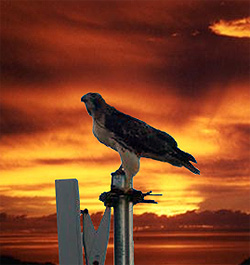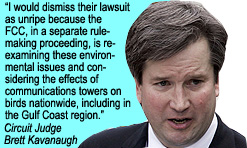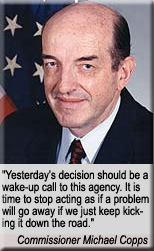|
FCC Commissioner welcomes the decision, but
Court's FCC split avian ruling seen as a blow to the tower siting community the tower siting community
February 20, 2008 - In a divided 2-1 decision, the U.S. Court of Appeals for the District of Columbia Circuit yesterday dealt a blow to the tower siting industry when it sided with conservation groups that claimed the Federal Communications Commission violated government rules by approving communications towers that threaten migratory birds.
The FCC previously rejected the groups' contention that it illegally licensed 6,000 towers in the Gulf Coast, from Texas to Florida, without first assessing the potential impact on migratory birds. The agency said the groups failed to make any specific allegations related to individual towers as required by its rules.
"We vacate the order because the commission failed to apply the proper NEPA [National Environmental Policy Act] standard, to provide a reasoned explanation on consultation under the ESA [Endangered Species Act], and to provide meaningful notice of pending tower applications," stated the court's decision. The court also ruled that the FCC didn't justify why it did not use federal wildlife experts to assess the environmental threat.
Earthjustice, the public interest law firm that argued the case for the American Bird Conservancy and the Forest Conservation Council, said that they thought it is a very significant ruling because it requires the FCC to carefully consider the environmental impact of communications towers on bird population, and it ensures the public will have timely notice of applications for tower permits.
Dissenting opinion says lawsuit is "unripe"
In his dissenting opinion, Judge Brett Kavanaugh said he would dismiss the  environmental groups' lawsuit "as unripe" because the FCC, in a separate rulemaking proceeding, is re-examining these environmental issues and considering the effects of communications towers on birds nationwide, including in the Gulf Coast region." environmental groups' lawsuit "as unripe" because the FCC, in a separate rulemaking proceeding, is re-examining these environmental issues and considering the effects of communications towers on birds nationwide, including in the Gulf Coast region."
"The Commission has gathered considerable factual information and input from interested parties - including from the petitioners in this case - and the FCC's counsel represented to the Court that the Commission expects to act soon," Judge Kavanaugh wrote.
For the complete court opinions on the petition, click here.
Twice in the last five years, the agency has delved into the complex bird-tower issues. In late 2006, the FCC opened a Notice of Proposed Rule Making, WT Docket No 03-187, for public input regarding its legal authority to adopt regulations on migratory bird collisions with towers. The comment period closed in May 2007, but the agency has yet to take final action.
During the comment period, WirelessEstimator.com provided the FCC with 20 letters from readers regarding the avian mortality issues affecting the possibility of new tower lighting and height limitation regulations.
The FCC received 2745 comments, the majority of them requesting that new obstruction lighting requirements and height limitations be placed upon communications structures. However, many hundreds of them were chain emails and others did not offer viable solutions or provide peer-reviewed scientific studies that could support the claims that as many as 50 million migrating birds die annually after colliding with a tower.
Environmentalists hope the ruling will encourage the FCC to approve proposed rules that would mandate white strobe lights on new towers nationwide.
The ruling also said that the FCC must determine how to give the public notice of new tower applications. The FCC now publicizes applications only after they have been approved.
Joe Ferrin, spokesman for the Cellular Telecommunications & Internet Association, said the organization had no immediate comment. "Our attorneys are still reviewing the decision," he said.
Commissioner Copps welcomes court's decision
FCC Commissioner Michael Copps took the opportunity of the court decision to criticize FCC environmental policies. criticize FCC environmental policies.
"For years, I have been disappointed with the FCC's failure to get serious about its environmental responsibilities," he said in a statement. "Now the D.C. Circuit has affirmed something this agency should have acknowledged a long time ago: that the National Environmental Protection Act, the Endangered Species Act and the Migratory Bird Treaty Act require the FCC to take a hard look at the effects of communications towers on migratory birds."
He added, "Yesterday's decision should be a wake-up call to this agency. It is time to stop acting as if a problem will go away if we just keep kicking it down the road."
Aviation agency addresses avian lighting issues
A Federal Aviation Administration official informed the PCIA last October that their agency's technical researchers were investigating the nighttime migratory bird issue and are anticipating being able to offer some tower lighting options this year.
"We're enthusiastic about this. We can't promise that we're going to come up with something that's going to be appropriate for everybody," said James Patterson, project manager at the FAA Technical Center.
Patterson said the FAA is examining whether traditional steady burning incandescent red lights can be reduced or eliminated and whether other lighting technologies can be utilized without negative consequences to tower owners.
FWS recommendations are taxing to the industry
The FCC has been reviewing the U.S. Fish and Wildlife Service's recommendations that:
-- Anecdotal evidence may be the best biological information available if robust studies have not been conducted.
-- Medium intensity white strobe lights for nighttime use is to be considered the preferred system over red obstruction lighting systems to the maximum extent possible without compromising aircraft navigation safety.
-- If medium intensity white strobe lights cannot be used, such as when a local zoning ordinance prohibits it, red strobe lighting should be required.
-- Retrofitting of towers to the new lamping systems should be done when tower broadcast licenses expire or when incandescent systems burn out. All towers must be retrofitted within no longer than five years following approval of the regulation.
-- New towers, where practicable, should be less than 200-feet above ground level, be of monopole or lattice design, contain no guy wires or lights, and restrict taller towers that have to be built from being guyed.
-- Provide limited use and more studies on the marking and painting of guy wires.
-- Tower developers must complete a site evaluation form and provide it to the U.S. Fish and Wildlife Service Ecological Services Field Office having jurisdiction for the area in which the tower is proposed to be located as part of the NEPA review process.
|